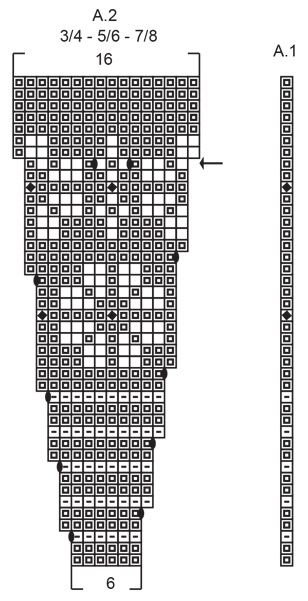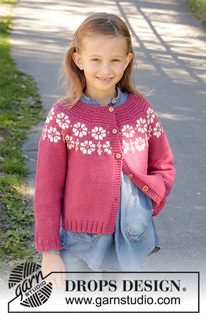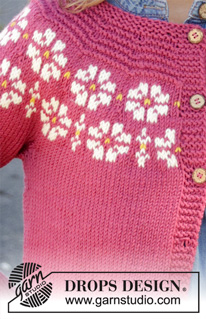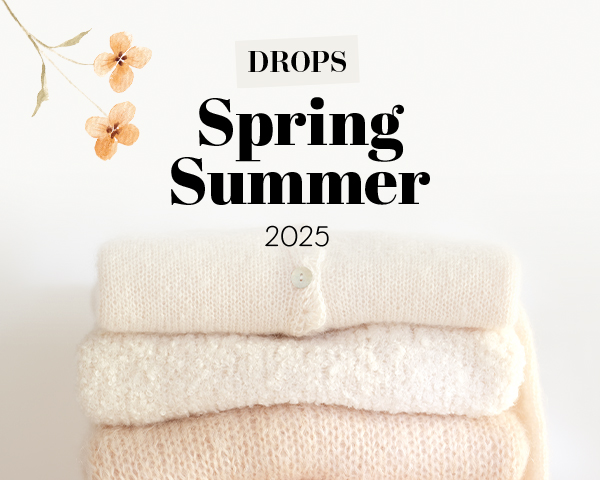Comments / Questions (42)
![]() Francoise wrote:
Francoise wrote:
Bonjour ! Est ce que je peux ajouter 2 mailles au début du tricot et 2 mailles à la fin ( donc 7 m de bordure ) pour avoir une finition en icord ?
09.06.2025 - 15:16
![]() Brigitte wrote:
Brigitte wrote:
Lorsque on doit augmenter dans l'empiècement doit-on faire 1 augmentation en répétant 15 fois le bloc des 6 mailles de base (du coup 7 mailles 15 fois ? où on augmente 1 fois en début de rang ? Pouvez vous éclaircir les explications s'il vous plaît J'ai posé plusieurs questions envoyées les unes après les autres Merci de les lire toutes les 3 pour la réponse Brigitte
29.03.2025 - 18:48DROPS Design answered:
Bonjour Brigitte, comme les augmentations ne se font que dans A.2, vous allez augmenter dans chaque A.2 comme indiqué dans le diagramme. Par ex, si vous devez répéter le diagramme 15 fois, vous aurez 15 augmentations à chaque fois, et (en taille 7/8 si j'ai bien compris), vous aurez ainsi 7 mailles dans chaque A.1 et 7x15 + 1 m de A.1 + 2 x5 m de bordure devant après le premier rang des diagrammes. Lorsque les diagrammes seront terminés, vous aurez ainsi: 5 m de bordure, 1 m de A.1, 15x16 m de A.2, 5 m de bordure = 251 mailles. Mettez éventuellement un marqueur entre chaque A.2 (et après A.1) pour mieux vous repérer et ainsi mieux vérifier votre nombre de mailles. Bon tricot!
31.03.2025 - 08:42
![]() Brigitte wrote:
Brigitte wrote:
Suite de ma question combien de fois doit on répéter A1 1 fois au début ou/et 1 fois avant chaque 6 m ??? Brigitte
29.03.2025 - 18:18DROPS Design answered:
Bonjour Brigitte, comme indiqué ci-dessous, A.1 ne va se tricoter qu'une seule fois, au début du rang sur l'endroit/à la fin du rang sur l'envers, après/avant la bordure devant; et on va répéter A.2 13 à 15 fois selon la taille. Bon tricot!
31.03.2025 - 08:35
![]() Brigitte wrote:
Brigitte wrote:
Bonjour. Je ne comprends pas où se place le diagramme A1 quand on commence l'empiècement on répète 14 fois A2 mais où mettons A1 ? Que veut dire au dessus la maille de suivantes? Merci de votre explication Brigitte
29.03.2025 - 18:11DROPS Design answered:
Bonjour Brigitte, on tricote A.1 en début de rang sur l'endroit puis on répète A.2 - sur l'envers, on répète A.2 en lisant bien le diagramme de gauche à droite et on termine par A.1. Le motif est ainsi symétrique. Lorsqu'il est indiqué de tricoter A.1 au-dessus de la maille suivante, on doit alors simplement tricoter la maille suivante en suivant le diagramme A.1. Bon tricot!
31.03.2025 - 08:35
![]() COSME Christiane wrote:
COSME Christiane wrote:
Bonjour en faisant les 2 premiers rg est ce que c' est 1 point de riz dans l ' attente d' une réponse je vous remercie Christiane C
23.12.2024 - 10:07
![]() Gouteux wrote:
Gouteux wrote:
Bonjour je fais la taille 7/8 ans je viens de commencer j'ai fait les premiers rangs jusqu'aux augmentations et ensuite passer A1 etA2 apparement ilya plusieurs rangs de point mousse et je ne comprends pas les infos ,le nombre de rangs et combien de mailles entre A1 et A2
11.11.2024 - 11:03DROPS Design answered:
Bonjour Mme Gouteux, lorsque vous avez augmenté après les 2 côtes mousse, vous avez 101 mailles que vous tricotez ainsi: 5 m point mousse, 1 maille comme indiqué dans le diagramme A.1, puis répétez maintenant 15 fois les 6 mailles du diagramme A.2 et terminez par 5 m point mousse, soit: 5+1+(15x6)+5=101 mailles. Sur l'envers, lisez le diagramme de gauche à droite. Augmentez comme indiqué dans A.2 = vous aurez 16 m dans chaque A.2 quand le diagramme est terminé, soit: 5+1+(15x16)+5=251 mailles. Bon tricot!
11.11.2024 - 12:48
![]() Teresa wrote:
Teresa wrote:
Per favore non capisco lo Schema!!! Mi potete spiegare meglio? Si legge dal basso verso l'alto? I ferri sono andata e ritorno? Grazie
10.11.2024 - 00:09DROPS Design answered:
Buonasera Teresa, i diagrammi si leggono dal basso verso l'alto, da destra verso sinistra per i ferri di andata e da sinistra a destra per quelli di ritorno. Buon lavoro!
11.11.2024 - 16:31
![]() Aud wrote:
Aud wrote:
Hva menes med: strikk A1 over 1 maske?
05.10.2024 - 21:35DROPS Design answered:
Hej Aud. Då stickar du 1 maska enligt diagram A.1. Se mer om strikkediagrammer här. Mvh DROPS Design
09.10.2024 - 08:54
![]() Cordelia wrote:
Cordelia wrote:
I am making the smallest size and just using one colour throughout. I can't work out the diagrams for how to do the increases with just one colour. I've done the 2 ridges, the first increase row, the following Knit row but am now stuck. Please help!
21.07.2024 - 20:38DROPS Design answered:
Dear Cordelia, even if you work with one colour, the instructions are worked exactly the same. There are 2 charts A.1 and A.2 depending on the size you are working; for the smallest size choose the second ones. You will work the pattern as follows: 5 band stitches in garter stitch, A.1 over 1 stitch, A.2 a total of 13 times on the row and 5 band stitches in garter stitch. You can ignore the colours and simply knit or purl depending on the side you are working on. The only thing to account for is the black oval, which are increases. Please read the following lesson for more information: https://www.garnstudio.com/lesson.php?id=68&cid=19. Happy knitting!
22.07.2024 - 01:32
![]() Gill Corris wrote:
Gill Corris wrote:
I am knitting the second size up and love the design. However, try as I might, I cannot get the increase mid-pattern row right (row 41 for me, marked with an arrow)- do I wrap the main colour yarn or the cream? The extra stitches show at the ends of the row, but the yarn overs are half way so the pattern ends up wrong. Please help!
07.05.2024 - 13:33DROPS Design answered:
Hi Gill Gorris! You do yarn-over with same colour as previous stitch, which makes 1 more dark stitch next row. Flower will be like one before, just on the diagram white squares move aside because new stitch. Hope it helps!
07.05.2024 - 15:23
Daisy Delight Cardigan#daisydelightcardigan |
|||||||||||||||||||
 |
 |
||||||||||||||||||
Knitted jacket for children in DROPS Merino Extra Fine. DROPS Lima or DROPS Cotton Light. The piece is worked top down with flowers, colored pattern, garter stitch and stockinette stitch. Sizes 3-12 years.
DROPS Children 34-5 |
|||||||||||||||||||
|
------------------------------------------------------- EXPLANATIONS FOR THE PATTERN: ------------------------------------------------------- RIDGE/GARTER STITCH (worked back and forth): 1 ridge = Knit 2 rows. PATTERN: See diagrams A.1 and A.2. Choose diagram for your size. The diagrams show all the rows in the pattern seen from the right side. INCREASE TIP-1 (evenly spaced): To work out how to increase evenly, count the total number of stitches on the needle (e.g. 72 stitches) and divide by the number of increases to be made (e.g. 17) = 4.2. In this example increase by making 1 yarn over after approx. each 4th stitch. On the next row work the yarn overs twisted to avoid holes. INCREASE TIP-2 (for sides of body): Work until there is 1 stitch left before the marker thread, 1 yarn over, knit 2 (marker thread sits in the middle of these 2 stitches), 1 yarn over = 2 stitches increased. On the next row work the yarn overs twisted to avoid holes. Then work the new stitches in stockinette stitch. DECREASE TIP (for sleeves): Decrease 1 stitch on each side of the marker thread as follows: Work until there are 3 stitches left before the marker thread, knit 2 together, knit 2 (marker thread sits in the middle of these 2 stitches), slip 1 stitch as if to knit, knit 1 and pass the slipped stitch over the knitted stitch = 2 stitches decreased. BUTTONHOLES: Work buttonholes on the right band (when garment is worn). 1 buttonhole = start from the wrong side and knit together stitches 2 and 3 from the edge, make 1 yarn over. On the next row knit the yarn over to leave a hole. The first buttonhole is worked after 1 cm = ⅜" on the neck and then the other 4-4-5-5-5 buttonholes are worked every 6-6-6-7-7 cm = 2⅜"-2⅜"-2⅜"-2¾"-2¾". ------------------------------------------------------- START THE PIECE HERE: ------------------------------------------------------- JACKET - SHORT OVERVIEW OF THE PIECE: The piece is worked back and forth with circular needle, top down, then the front and back pieces are worked back and forth. The sleeves are worked in the round with short circular needle/double pointed needles. YOKE: Cast on 72-76-80-86-92 stitches with circular needle size 4 = US 6 and heather/cerise/dark red. Work 2 RIDGES – see description above – remember BUTTONHOLES on right band – see description above. Knit 1 row where you increase 17-19-21-23-24 stitches evenly on row - READ INCREASE TIP-1! = 89-95-101-109-116 stitches on needle. Knit 1 row from the wrong side. Insert a marker in this row and measure onwards from here. Work according to diagrams A.1 and A.2 from the right side as follows: Work 5 band stitches in GARTER STITCH, A.1 over 1 stitch, A.2 a total of 13-14-15-14-15 times on the row and 5 band stitches in garter stitch. REMEMBER THE KNITTING GAUGE! When diagrams A.1 and A.2 have been completed in height there are 219-235-251-263-281 stitches on the needle. On the next row from the right side increase 3-3-5-1-5 stitches evenly on row = 222-238-256-264-286 stitches. Continue with stockinette stitch and 5 band stitches in garter stitch on each side until the piece measures 15-15-16-17-18 cm = 6"-6"-6¼"-6¾"-7" from the marker. The next row from the right side is worked as follows: Work 5 band stitches in garter stitch, 31-33-36-37-38 stitches in stockinette stitch (= front piece), place the next 44-48-51-53-62 stitches on a thread (= sleeve), cast on 6 new stitches under the sleeve, work 62-66-72-74-76 stitches in stockinette stitch (= back piece), place the next 44-48-51-53-62 stitches on a new thread (= sleeve), cast on 6 new stitches, work 31-33-36-37-38 stitches (= front piece) and 5 band stitches in garter stitch. BODY: There are 146-154-166-170-174 stitches on the needle. THE PIECE IS NOW MEASURED FROM HERE! Insert 1 marker thread in the middle of the 6 new stitches cast on under each sleeve. Work stockinette stitch back and forth, with 5 band stitches in garter stitch on each side. When the piece measures 3 cm = 1⅛" increase 1 stitch on each side of each marker (= 4 stitches increased) READ INCREASE TIP–2! Repeat the increase every 3-4-5-6-7 cm = 1⅛"-1½"-2"-2⅜"-2¾" a total of 3 times = 158-166-178-182-186 stitches on the needle. Continue working as before until the piece measures 12-16-19-22-25 cm = 4¾"-6¼"-7½"-7¾"-9¾". Work 1 row from the right side where you increase 10-10-10-10-10 stitches evenly on row (do not increase on the bands) = 168-176-188-192-196 stitches. The next row is worked as follows from the right side: Work 5 band stitches in garter stitch, purl 2, * knit 2, purl 2 *. Work from *-* until there are 5 stitches left and work 5 band stitches in garter stitch. Continue this rib for 3 cm = 1⅛". On the next row from the right side bind off with garter stitch over garter stitch, knit over knit and purl over purl. Cut and fasten the strand. SLEEVE: Place the stitches from one thread on short circular needle/double pointed needles size 4 mm = US 6 (= 44-48-51-53-62 stitches) and knit up 1 stitch in each of the 6 stitches cast on under the sleeve (= 50-54-57-59-68 stitches). Insert 1 marker thread in the middle of these 6 stitches. Work stockinette stitch in the round for 2 cm = ¾". Now decrease 1 stitch on each side of the marker thread - READ DECREASE TIP. Continue with stockinette stitch and repeat the decrease every 4-3½-4-4-3½ cm = 1½"-1¼"-1½"-1½"-1¼" until you have decreased a total of 5-7-7-8-10 times = 40-40-43-43-48 stitches on the needles. Work stockinette stitch until the sleeve measures 22-27-30-34-37 cm = 7¾"-10⅝"-11¾"-12⅜"-14½". Work 1 round and increase 4-4-5-5-4 stitches evenly on the round = 44-44-48-48-52 stitches. Work rib in the round with knit 2 / purl 2 for 3 cm = 1⅛". Loosely bind off with knit over knit and purl over purl. Cut and fasten strand. Work the other sleeve in the same way. ASSEMBLY: Sew buttons onto left band. |
|||||||||||||||||||
Diagram explanations |
|||||||||||||||||||
|
|||||||||||||||||||

|
|||||||||||||||||||

|
|||||||||||||||||||

|
|||||||||||||||||||
Have you finished this pattern?Tag your pictures with #dropspattern #daisydelightcardigan or submit them to the #dropsfan gallery. Do you need help with this pattern?You'll find 29 tutorial videos, a Comments/Questions area and more by visiting the pattern on garnstudio.com. © 1982-2025 DROPS Design A/S. We reserve all rights. This document, including all its sub-sections, has copyrights. Read more about what you can do with our patterns at the bottom of each pattern on our site. |
|||||||||||||||||||


















































































Post a comment to pattern DROPS Children 34-5
We would love to hear what you have to say about this pattern!
If you want to leave a question, please make sure you select the correct category in the form below, to speed up the answering process. Required fields are marked *.